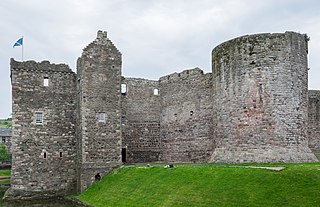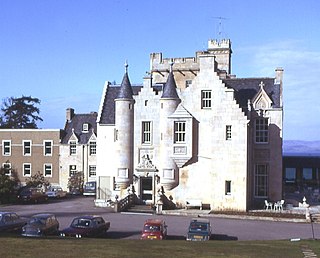
Rothesay is the principal town on the Isle of Bute, in the council area of Argyll and Bute, Scotland. It lies along the coast of the Firth of Clyde. It can be reached by ferry from Wemyss Bay, which offers an onward rail link to Glasgow. At the centre of the town is the 13th-century ruin Rothesay Castle, unique in Scotland for its circular plan.

The County of Bute, also known as Buteshire, is a historic county and registration county of Scotland.

The Isle of Bute, known as Bute, is an island in the Firth of Clyde in Scotland, United Kingdom. It is divided into highland and lowland areas by the Highland Boundary Fault.

Cowal is a peninsula in Argyll and Bute, in the west of Scotland, that extends into the Firth of Clyde.

Kilchurn Castle is a ruined structure on a rocky peninsula at the northeastern end of Loch Awe, in Argyll and Bute, Scotland. It was first constructed in the mid-15th century as the base of the Campbells of Glenorchy, who extended both the castle and their territory in the area over the next 150 years. After the Campbells became Earls of Breadalbane and moved to Taymouth Castle, Kilchurn fell out of use and was in ruins by 1770. It is now in the care of Historic Environment Scotland and is open to the public in summer.

Duart Castle, or Caisteal Dhubhairt in Scottish Gaelic, is a castle on the Isle of Mull, beside the Sound of Mull off the west coast of Scotland, within the council area of Argyll and Bute. The castle dates back to the 13th century and is the seat of Clan MacLean. One source states that the castle was "brought back from ruin in 1911".

The Kyles of Bute form a narrow sea channel that separates the northern end of the Isle of Bute from the Cowal peninsula in Argyll and Bute, on the Scottish mainland. The surrounding hillsides are roughly wooded, and overlooked by rocky tops and areas of moorland.

Dunstaffnage Castle is a partially ruined castle in Argyll and Bute, western Scotland. It lies 3 miles (5 km) NNE of Oban, situated on a platform of conglomerate rock on a promontory at the south-west of the entrance to Loch Etive, and is surrounded on three sides by the sea. The castle and the nearby chapel ruin have been a Historic Scotland property since 1958. Both are Scheduled Ancient Monuments.

Carnasserie Castle is a ruined 16th-century tower house, noted for its unusual plan and renaissance detailing. It is located around 2 kilometres north of Kilmartin, in Argyll and Bute, western Scotland, at grid reference NM837009.

Dalmally is a village in Argyll and Bute, Scotland. It is near the A85 road and is served by Dalmally railway station.

Rothesay Castle is a ruined castle in Rothesay, the principal town on the Isle of Bute, in western Scotland. Located at NS086646, the castle has been described as "one of the most remarkable in Scotland", for its long history dating back to the beginning of the 13th century, and its unusual circular plan.

Ascog is a small village on the Isle of Bute, within Argyll and Bute council area, Scotland. The village is within the parish of Kingarth, and is situated on the A844. It is located on the east coast of the island, about 2 km to the south east of Rothesay. It is largely residential.

Craignish Castle is located on the Craignish peninsula in Argyll, western Scotland. The present castle includes a 16th-century tower, the seat of the Campbell family of Craignish and Jura. In the 19th century it was sold to the Trench-Gascoigne family of Parlington Hall, Yorkshire, who built a large extension to the tower. In the later 20th century the house was restored, and parts of the 19th-century extension were demolished.

Stonefield Castle is a Scottish baronial manor house near the village of Stonefield, north of Tarbert, [[]], Argyll & Bute, Scotland. It was built on the site of an earlier building, known as Barmore, and has been in use as a hotel since 1950.

Ardpatrick House is a category-B-listed 18th-century country house in Ardpatrick, South Knapdale, Argyll and Bute, Scotland.

Dunoon Castle is a ruined castle located at Dunoon on the Cowal peninsula in Argyll and Bute, Scotland. The castle sat upon a cone-shaped hill of about 80 feet high, a volcanic plug. Very little remains of the castle's structure today. Castle House, built in 1822, stands a few yards north of the castle ruins.

New Castle Lachlan, is an 18th-century baronial mansion or country house located at Strathlachlan, Cowal peninsula, Argyll and Bute, Scotland. It was built in 1790 by Donald Maclachlan, 19th laird, to replace the 15th century Old Castle Lachlan, which stands nearby on the shores of Loch Fyne. The building is protected as a category C listed building.

Ochiltree Castle is a 16th-century tower house a few miles south east of Linlithgow in West Lothian, Scotland. It is also described as a farmhouse and lairds house. Along with its boundary wall, the castle was designated as a Category A listed building in 1971.

Loch Ascog is a small reservoir on the east coast of the island of Bute, in the council area of Argyll and Bute, Scotland. The loch supplies water to the town of Rothesay and the fishing rights are held by the Isle of Bute Angling Association. Loch Ascog is 44.7 hectares in extent. To the west is the much larger Loch Fad.

Rothesay Town Hall and County Buildings is a former municipal building in Castle Street, Rothesay, Scotland. The structure, which was the meeting place of Rothesay Burgh Council and of Bute County Council, is a Category B listed building.




















